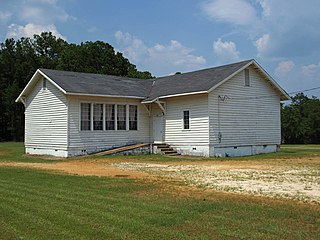Related Research Articles

This is a list of the National Register of Historic Places listings in Hale County, Alabama.

This is a list of the National Register of Historic Places listings in Macon County, Alabama.

This is a list of the National Register of Historic Places listings in Marengo County, Alabama.
The following is a list of Registered Historic Places in Iron County, Michigan. The list includes 79 structures and historic districts that are significant for their architectural, historical, or industrial/economic importance.
The Plantation Houses of the Alabama Canebrake and Their Associated Outbuildings Multiple Property Submission is a multiple property submission of properties that were together listed on the National Register of Historic Places. The multiple property submission covers plantation properties that are within the Alabama Canebrake. The National Park Service has determined that all are historically or architecturally significant as a surviving group of plantation structures in what was once one of the wealthiest areas of the state.

This is a list of the National Register of Historic Places listings in Allen County, Ohio.

This is intended to be a complete list of the properties and districts on the National Register of Historic Places in the city of Pasadena, California, United States. The locations of National Register properties and districts for which the latitude and longitude coordinates are included below, may be seen in an online map.
The Antebellum Homes in Eutaw Thematic Resource is a multiple property submission of houses that were listed together on the National Register of Historic Places. It covers twenty-three properties in Eutaw, Alabama, all built prior to the American Civil War.

The Emory School, also known as the Tunstall School, is a historic Rosenwald School building in rural Hale County, Alabama, United States. It was built in 1915 to the designs of W.A. Hazel to serve the local African American community. The money to build the school was provided by the Julius Rosenwald Fund. The school was listed on the National Register of Historic Places on February 20, 1998, as a part of The Rosenwald School Building Fund and Associated Buildings Multiple Property Submission.

The Oak Grove School is a historic Rosenwald School building in rural Hale County, Alabama, United States. It was built to the designs of Samuel Smith in 1925 to serve the local African American community. The money to build the school was provided by the Julius Rosenwald Fund. The school was listed on the National Register of Historic Places on March 3, 1998, as a part of The Rosenwald School Building Fund and Associated Buildings Multiple Property Submission.

This is a list of the National Register of Historic Places listings in Newberry County, South Carolina.

New Hope Rosenwald School is a Rosenwald School near Fredonia, Alabama, United States. It was built in 1915. It was listed on the National Register of Historic Places as part of The Rosenwald School Building Fund and Associated Buildings Multiple Property Submission on November 29, 2001.

The Mount Sinai School is a historic Rosenwald School in rural Autauga County, Alabama, US, northwest of Prattville. The one-story frame building was built in 1919 to the designs of W.A. Hazel to serve the local African American community. The money to build it was provided by the Julius Rosenwald Fund. The school was added to the Alabama Register of Landmarks and Heritage on February 2, 2001. It was subsequently listed on the National Register of Historic Places on November 29, 2001, as a part of The Rosenwald School Building Fund and Associated Buildings Multiple Property Submission.

The Tankersley Rosenwald School, also known as the Tankersley Elementary School, is a historic American Craftsman-style school building in Hope Hull, Alabama, a suburb of Montgomery. This Rosenwald School building was built in 1922 to serve the local African American community. The money to build the school was provided, in part, by the Julius Rosenwald Fund. It was added to the Alabama Register of Landmarks and Heritage on June 26, 2003, and to the National Register of Historic Places as a part of The Rosenwald School Building Fund and Associated Buildings Multiple Property Submission on January 22, 2009.

This is a list of the National Register of Historic Places listings in Waller County, Texas.
The Historic Roman Catholic Properties in Mobile Multiple Property Submission is a multiple property submission of Roman Catholic properties in Mobile, Alabama, that were listed together on the National Register of Historic Places. The submission covers cemetery, church, convent and other religious properties that are historically or architecturally significant.
The 19th Century Spring Hill Neighborhood Thematic Resource is a multiple property submission of buildings that were listed together on the National Register of Historic Places. It covers eight properties in the Spring Hill neighborhood of Mobile, Alabama, all built during the mid-19th century.
The Spanish Revival Residences in Mobile Multiple Property Submission is a multiple property submission of buildings that were listed together on the National Register of Historic Places as some of the best remaining examples in Mobile, Alabama of houses built in the Spanish Colonial Revival style. It covers ten properties.
References
- 1 2 "The Rosenwald School Building Fund and Associated Buildings MPS". "National Register Information System". Retrieved October 26, 2011.